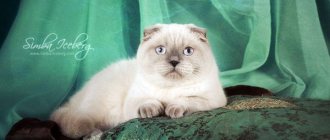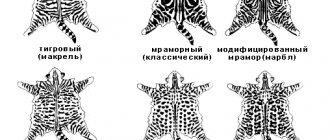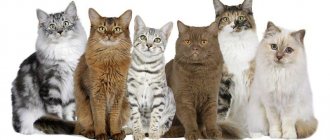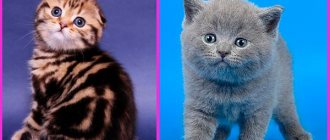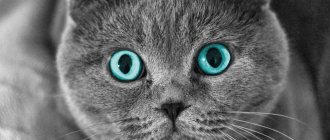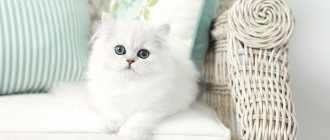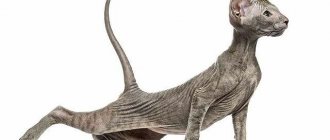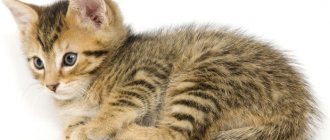If you ask the average person what color Scottish cats are, he will certainly answer that they are gray (the color among professionals is called blue). This is a common color of Scottish cats. But today the variety of colors is very large. Therefore, when asked what colors of Scottish cats there are, you must boldly answer: any! To get such a wide palette, Scots had to be crossed with other breeds. Today, interbreeding is not encouraged, because cats already have the necessary set of genes.
In this article we will answer the following questions: what color are Scottish kittens, what color are Scottish cats, what are the main genes that form the colors of Scottish Fold and Straight-eared cats (Scottish Straight, Scottish Fold, Highland Straight and Highland Fold). Also in the article we will talk about how the color of Scottish kittens changes with age, and show photos of Scottish cats and kittens of almost all colors. Absolutely all colors cannot be presented within the framework of the publication, because... there are a lot of them, and the genes, combining in a bizarre way, still surprise breeders.
Article continues after advertisement
Plain (solid, solid)
The monochrome uniform coloring of Scottish cats is considered classic by breeders. The solid or solid color of the animal implies the absolute exclusion of any inclusions, small marks and specks of a different color. The tone is rich, even along the entire length of the coat.
The most common used to be considered blue plain Scots. But today among the representatives of the breed there are many other variants of solid colors.
White
A Scottish cat with snow-white fur (without yellowness) looks luxurious. Possible eye colors are blue, amber, copper. According to the standard, eyes of different colors are allowed. The paw pads and nose are light pink.
Kittens may have markings of a different shade, which disappear after the first coat change. By the age of two, the coat of a white Scot should be crystal clear, without spots of a different color.
Black
The black cat has expressive yellow eyes. The nose and paw pads practically blend into the main color of the animal.
On the shiny bright coat of the Scottish beauty Ebony, 2-3 hairs of contrasting white color are allowed. The presence of large red or brown marks is not provided for by the standard.
Important: Scottish Fold pets are endowed with magical abilities. It is believed that it is the black color of the Scottish Fold that protects the house and its inhabitants from evil spirits.
Chocolate
The brown Scottish cat, also called chocolate, looks noble and impressive. The color of the coat contrasts with the animal's yellow, golden or copper eyes. The nose and paw pads are also dark brown.
Lilac (lavender)
The monochromatic lilac Scottish Fold has a gentle gray tint that smoothly turns into cream. The nose is slightly brownish, the paws on the bottom are the same color as the coat, in harmony with the main color of the pet. This lilac-lavender color goes well with eyes of copper, amber or orange shades.
Red (red)
Red or ginger color is a rare and valuable color of the Scots breed. The fiery edge is combined with burning amber irises. Pads and nose to match the dominant color.
The tail of kittens and adult animals is not very evenly colored. This deficiency does not disappear with age and is allowed by the standard. And the presence of marks on the head and limbs that remain after reaching the age of two are considered a deviation from the norm.
A red Scottish straight-eared cat can give birth to kittens not only with erect ears, but also with ears pressed to the head.
Cream
The cream or peach fold cat is infinitely elegant and beautiful. The delicate background of light fur, bright golden eyes and a pinkish nose give the pet an irresistible appearance. The pads on the paws are also pink. An animal with this color is similar to a red Scotsman, but its coat color is a shade lighter.
A peach fold kitten may have a blurry, fuzzy pattern on its paws and tail that does not disappear with age. This is not critical for a purebred pet, but leopard markings are absolutely unacceptable.
Faun (deer)
There is another unique color of Scottish fold cats with an interesting name - fawn, which means “young deer”. The nose and pads on the paws of these beauties are beige-pink.
Cinnamon
Cinnamon is a lighter and more delicate color than chocolate, but darker than red. The nose and paw pads of such animals are brown, beige or pink.
Blue color (blue)
The gray or blue Scottish cat has very beautiful amber eyes. The coat tone of a purebred pet can belong to any range of gray - from the lightest (blue) to completely dark (blue). At the same time, each hair is saturated and well colored, without streaks.
The nose and pads practically do not differ in color from the plain coat.
A gray Scottish Straight cat may be marked with a few streaks and drawings in childhood. But as they grow older, these color flaws go away.
Care instructions
Many purebred pets have an innate tendency to a large number of diseases. This is due to the fact that breeders raise kittens exclusively for sale; for most of them, external data is much more important than the health of the kitten.
- Therefore, immediately after purchasing a pet, you need to take it to an appointment with a veterinarian, he will conduct a detailed examination and prescribe several vaccinations that will help protect the pet from various types of parasites.
- Anti-worm medications will also be prescribed, which are given to the kitten at intervals of 10 days until the parasites are completely eliminated, only if they were detected during examination. Medicines may also be prescribed to prevent their occurrence.
The issue of sterilization is not so pressing at present, because there are drops and tablets on sale that reduce the sexual desire of animals during the period of exacerbation. This allows you to avoid serious health and hormonal problems.
Two-color
A unique coat color is bicolor (two-color cats). The main background is snow-white. The second color in color (cream, black, blue, red) is presented in the form of unusual patterns. Thoroughbred representatives must have white belly, neck, chest, paws, muzzle and beard.
A prerequisite is the predominance of a white background in color. Bicolors are more valued; their body patterns are symmetrical. The eyes can be any shade, but are usually blue or golden yellow.
Cream bicolor
Cute white cats with additional streaks of delicate cream tones. The eyes are blue or yellow, and the nose and pads are pink.
Blue bicolor
The pattern on the wool is blue (delicate or rich gray). The iris of the eyes is a beautiful sky tone or yellow-orange. The nose and paws below are pink.
Black bicolor
Black and white bicolor is characterized by patterns of rich black tone. These cats have a pink nose and blue or copper eyes. A symmetrical, distinct pattern on the skin turns the cat into a real gentleman in a tailcoat.
Rules for choosing a kitten
You should buy a kitten at the age of 3-4 months, this will allow you to avoid making a mistake in choosing a color for those who are looking for a marbled Scotsman. You should focus on a specialized nursery, whose breeders have been doing their business for a long time, have many good reviews and a license to breed the breed. As a rule, such people are not prone to deception, since they greatly value the reputation they have accumulated over the years.
The kitten acquires its “signature” color by the age of three months, but to be completely convinced of its quality, you should look at the entire litter and the parents
An experienced breeder can provide certificates confirming the health of the parents and their offspring, and he will not refuse to demonstrate the conditions in which he keeps his pets.
The kitten itself must be well-groomed and healthy. His eyes, nose and ears should be clean, his belly well-fed, and his fur combed, without lumps or debris in the hairs. The kitten should be curious, playful and not shy.
Color point
Color-point is translated from English as “colored point”. The point coloring is explained by the presence of a gene, under the influence of which the coloring of hairs intensifies in some areas of the body with insufficient blood circulation. Characteristic darkening appears on the main white or cream background of the coat.
The second name of the color is Point Links. The eye color of cats of this color is necessarily blue. Previously, this coat color was observed only in the Siamese breed. But today it is present in other cat species, including Scots.
Newborn kittens are completely white. Only by the age of one month do babies begin to show color on their ears, paws, tail and face. According to this color, several subspecies are distinguished among the points.
Blue Point
This color is characterized by a pale gray-blue, almost white shade of the body with darker, gray markings. Soft gray Scottish blue point kittens have paws and noses that match the main color.
Cream point
The body is creamy white, and the shading on the animal’s face and tail are pastel cream colors. Paw pads and nose are pink. This point color goes harmoniously with the expressive blue eyes of the cat.
Lilac Point
The dominant tone is soft white or lilac, and the markings are gray with a pink tint. The nose and paws are the same as the main color.
Seal Point
The darkest color among the points. The dominant tone is beige. Contrasting with it are brown and black markings. The same dark nose button and paw pads.
Chalklit Point
Chocolate or choclit point is distinguished by a brown pattern on a cream background. Paw pads and nose range from light cocoa to darker brown.
Red point
The main coat color is pale apricot, almost white. Darkening on certain parts of the body is red-red in color. The pads and tip of the nose are bright pink.
Colorful
Colored or color-point are colors in which the main body color is light (white or cream), and the ears, muzzle, tail and paws have a darker shade. The Scots owe this rare color to their British ancestors, who had Persian cats in their family.
Tortoiseshells (torties)
The tortoiseshell color of Scottish Folds is usually tri-colored. Red, white, and black spots are located on a cream or red dominant background. When the genes of the parents are combined in a tortoiseshell kitten, these markings can take on chocolate, blue and cream shades.
When assessing tortoiseshell cats, felinologists pay attention to the even distribution of markings and the intensity of their tone. Fold-eared and straight-eared Scots with a tortoiseshell color are divided into subspecies (depending on the color scheme of the spots).
Black-red
There are black and red-red patterns all over the cat's body. The sizes and shapes of the spots are very diverse. This color is often called tortie.
Chocolate red
The patterns on the wool are brown and red. They stand out against a lighter background and look very interesting. The chocolate red color is considered rare and prized by breeders.
Blue-cream
The tortoiseshell blue-cream color in Scottish pets is determined when the main gray-blue background is covered here and there with small light cream spots.
Important: tortoiseshell coloring is characteristic only of cats. The calico cat is very rare. The appearance of a male tortoiseshell kitten indicates genetic problems. Most likely, an adult pet will not be able to have offspring, since the reproductive functions of its body are impaired.
Nutrition
To have a healthy pet, a Scottish Fold, you need to take care of its nutrition. From the moment a cat appears in the house, you need to determine what its diet will be. Some owners prefer to feed their pets natural food, others high-quality dry food. What veterinarians do not recommend is mixing food. Having chosen a certain method of feeding, you need to stick to it.
If these are natural foods, then they should include boiled chicken, beef or offal. Fish and liver should only be given to the cat boiled. If your pet likes cereals, you can give rice, millet and oats cooked in broth or milk. Fermented milk products are good for the stomach: low-fat cottage cheese and kefir.
If the choice falls on feeding dry food, you need to choose only premium food. They contain vitamins and microelements. Moreover, food is divided according to age. Young cats need only trace elements, while older cats need supplements for bone tissue and gentle digestion of food.
Smoky (smoky, tuxedo)
The color of Scottish Fold cats can be smoky. On top the coat is one color, for example black. And at the base, each hair is silvery-white. This coloring is characteristic of cats with a dominant silver gene, which creates unusual combinations of light and dark shades.
Smoky color is easy to confuse with solid color. To avoid mistakes, you just need to look at the undercoat. With a smoky color, the undercoat of a different shade is clearly visible, and with a solid color, the color of the roots does not differ from the tips.
The eyes of smoke cats are usually yellow-gold in color. Based on the shades of smoke on the fur, several subspecies of this color of animal are distinguished.
Blue smoke
Smoky blue Scottish Straights and Scottish Folds are distinguished by the color of their fur coat with a gray cold coating. But underneath the fur is white and silvery. The paw pads and nose of these pets are gray-blue.
Black smoke
This color in Scottish cats is characterized by a black edge, but the hair at the roots is white. The nose mirror and pads do not differ from the main background.
Chocolate smoke
The snow-white undercoat is combined with a brown-chocolate topcoat. The nose button and paw pads of these animals are brown in color.
Smoky Scottish Straights and Scottish Folds, despite their unique color, cannot participate in exhibitions. Such cats are not recognized by the breed standard.
Pet's habitat
The pet must have a bed or house. When choosing a cozy “cat house” for your cat, you need to make sure that it is not small, but matches her size. Cats do not always sleep curled up in a ball; sometimes they stretch out to their full height, completely relaxing. Only the breed of fold-eared cats likes to sit with their hind legs extended, placing their front legs on their stomachs in the “Buddha pose.”
Since the Scottish Fold marbled cat (her photo is posted in the article) was bred for domestic keeping, she needs “gymnastic equipment” where she can keep herself in shape. These can be all kinds of structures made of wooden sticks and shelves.
To prevent your pet from damaging furniture and upholstery, she must have a scratching post, the height of which would allow her to stretch out to her full height during the procedure. In addition, the claws on the front paws need to be trimmed a couple of times a month by at least 2-3 mm. On the rear, it is enough to shorten once a month. Cats do not like this procedure, so they need to be taught to cut their nails from childhood. Claws are cut only with a special nail clipper, and not with scissors. They can disrupt the tissue structure and injure the claw.
Tabby colors
Scottish tabby cats are very popular among breed lovers. This color suggests the presence of patterns on the pet’s fur.
Depending on their shape and size, tabbies are divided into three types:
- Striped (tiger) color - the presence of clearly defined vertical stripes.
- Spotted (leopard) - the pattern is made up of spots on the animal's fur.
- Marble color is a pattern of larger chaotic marks of different shapes.
A prerequisite for tabby cats is the presence of the letter “M” on the top of the animal’s forehead. The color combinations of wool are surprising in their diversity:
- cream;
- golden;
- blue;
- marble on silver;
- black marble;
- silver;
- silver-blue.
Important: Scottish tabbies with a silver tabby color resemble the mustachioed pet from a cat food commercial. Many believe that it is the Scottish straight-eared cat with a tabby pattern that appears on the screen. This color is also called the whiskey color of Scottish cats.
Color standards and disqualification
Professional systems of felinologists where the Scottish Fold cat breed is recognized: WCF, CFA, TICA, ACF, ACFA. They all have their own characteristics, but in general there is a set of color standards for the Scottish breed. If an animal does not comply with them, it is disqualified from all breed shows and competitions and cannot be allowed to breed. Of course, a cat disqualified for color can have offspring if the owner does not want to sterilize it. But her kittens will never have a pedigree that is recognized among breeders.
Table of Scottish cat colors and disqualifications.
The variety of colors of Scots is huge. To obtain such a palette, the breeder needed decades of crossings with other breeds similar in genotype. Today, crossing with other breeds is practically not used (unless we are talking about Scottish Folds), since the Scots have already received a stable set of genes necessary to continue their pedigree.
Chinchilla
The Scottish chinchilla borrowed the extravagant colors of its coat from the British, and they, in turn, from Persian cats. A chinchilla kitten is born only from parents with an unusual color. Each hair is colored in two colors.
Most of it is light in color and 1/8 of it (the top) is dark in color. This phenomenon is called tipping.
Tipped chinchilla colors can be of 3 types:
- Golden. The cat has a white undercoat. But on top there is a reddish coating over almost the entire surface of the body (on the sides, back and tail of the animal). Only the beard, the tips of the ears and the belly are white. Yellow-gold eyes, pink pads and a brick-colored nose.
- Silver. White wool coated with silver gives an interesting gray effect. The color of the tail has a hint of stripes, the nose is beige, and the eyes are green. Snow-white tips of the pet's ears, chin and belly.
- Blue golden. The rarest and therefore valuable color of Scottish chinchillas. The undercoat is a delicate caramel color, and the tips of the hair are a radiant blue hue. The eyes are natural emeralds of a rich green tone.
Health
You need to purchase a kitten only from breeders in order to be absolutely sure that the kitten was born from the correct mating. When choosing a kitten, you need to pay attention to its mobility. He should not be slow in his movements.
The place where the kitten usually sleeps should not be in a draft. He may catch a cold and get bronchitis. Apart from the ears, weak points include the eyes; you need to make sure that they do not water. Wipe them with a special liquid. Veterinarians recommend that your pet be vaccinated in accordance with established standards, before which mandatory deworming is carried out.
Shaded (shedded) colors
An unusual definition refers to the interesting color of Scottish cats - shaded colors. These pets have almost white fur, but the tip of the guard hair is colored.
The top layer of a cat's coat can be any shade typical of Scottish cats. The undercoat is white. The sides, back, head, tail and ears are shaded. Light belly, chin and lower tail. There should be no obvious spots. The “M” sign on the forehead and darkish rings on the paws are acceptable.
Shedded colors can be of three varieties:
- Golden. The fur of the Scottish cat is golden, the undercoat is cream or light peach. Green eyes are very expressive and beautiful. The nose button and paw pads are chocolate.
- Red. This type of shaded color has a dark red coating on the coat with a snow-white undercoat. The eyes are amber, the pads and nose are pink.
- Silver. The white undercoat combined with the dark gray topcoat produces an amazing gray tint. Greenish eyes are lined with black stripes. This feature is typical only for the silver shedded color. Other varieties have eyes without a contour. The nose is brick-colored and the mouth is dark-lined.
Bicolors
The coat color of these beautiful creatures has two colors, and a combination of white and any other shade is mandatory. Purebred bicolors must have a white belly, neck, chest, chin, limbs and, of course, muzzle.
Particolor (calico)
A Scottish cat of this type, called particolor, is a combination of white with tortoiseshell or spotted tabby color.
Harlequin
Harlequin captivated everyone with his unusual appearance. The cat is painted white (4/5 parts of the body), but the tail must be black, as well as the ears and the top of the head. The ventral part is white. The tip of the nose, like most people, is the same color – pink.
Wang
This breed only has colored tail, and sometimes has a few spots on the head. It happens that there are solid spots on the paws and back, but this is considered undesirable. When this breed develops red spots, it may also be called a Red Van.
